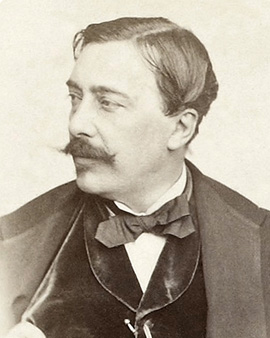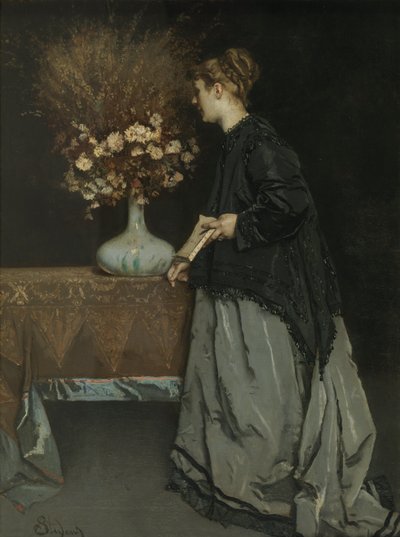Alfred Emile Stevens was a painter with a passion for lithography. He grew up sheltered in his native Belgium. His mother and father were both interested in art and gave their son the love of painting. As a young man, Stevens was overcome with wanderlust, so he set off for France. He settled in Paris - a promising place for artists of then and now.
Surrounded by Impressionists with whom he maintained close friendships and business relationships, Stevens set out in search of his very own personal painting style. Although he was never an Impressionist and never wanted to be, the viewer can see that Stevens was artistically inspired by the movement. The broken brushstrokes, the dark stripes of the background color and the Japanese elements, which are major components of Impressionist painting, can also be found in Stevens' paintings. Stevens became famous for his society portraits of beautiful aristocratic women: feminine ladies in contemporary dress in scenes that were very intimate for the time. With this he had found his favourite motif. These popular pictures earned him the honorary status of the Parisian art scene quite early in his career. This meant the automatic acceptance of each of his paintings at every exhibition of the prestigious Paris Salon.
In the following decades his success grew. His paintings were acquired by renowned buyers such as the Brussels Museum and the Belgian King Leopold. In 1867 he participated in the great Paris World Exhibition and won a number of first-class medals and promotion to officer of the Legion of Honour with his paintings. The year 1880 marked the peak of Alfred Emile Steven's career. He had achieved almost everything that could be achieved in his profession and was praised as one of the best painters of his time.
In the 1890s he gradually ended his active career. But he never disappeared from memory. In 1900, while he was still alive, he had his first retrospective exhibition at the Ecole des Beaux-Arts, the art academy in Paris, which celebrated his legacy to painting.
×





.jpg)
.jpg)
.jpg)
.jpg)
.jpg)
.jpg)


.jpg)
.jpg)
.jpg)
.jpg)
.jpg)
.jpg)
.jpg)
.jpg)
.jpg)
.jpg)
.jpg)
.jpg)
.jpg)
.jpg)
.jpg)
.jpg)
.jpg)
.jpg)
.jpg)
.jpg)
.jpg)
.jpg)
.jpg)
.jpg)
.jpg)
.jpg)
.jpg)
.jpg)
.jpg)
.jpg)
_-_(MeisterDrucke-900929).jpg)
_-_(MeisterDrucke-900929).jpg)
.jpg)
.jpg)
.jpg)
.jpg)
.jpg)
.jpg)
.jpg)
.jpg)
.jpg)
.jpg)
.jpg)
.jpg)
.jpg)
.jpg)
.jpg)
.jpg)
.jpg)
.jpg)
.jpg)
.jpg)
.jpg)
.jpg)
.jpg)
.jpg)
.jpg)
.jpg)
.jpg)
.jpg)
.jpg)
.jpg)
.jpg)
.jpg)
.jpg)
.jpg)
.jpg)
.jpg)
.jpg)
.jpg)
.jpg)
.jpg)
.jpg)
.jpg)
.jpg)
.jpg)
_1859_Oil_on_-_(MeisterDrucke-961487).jpg)
_1859_Oil_on_-_(MeisterDrucke-961487).jpg)
.jpg)
.jpg)
.jpg)
.jpg)
.jpg)
.jpg)
_-_(MeisterDrucke-898292).jpg)
_-_(MeisterDrucke-898292).jpg)
.jpg)
.jpg)
.jpg)
.jpg)
.jpg)
.jpg)
.jpg)
.jpg)
.jpg)
.jpg)
.jpg)
.jpg)
.jpg)
.jpg)
.jpg)
.jpg)
.jpg)
.jpg)
.jpg)
.jpg)
.jpg)
.jpg)
_-_(MeisterDrucke-1440044).jpg)
_-_(MeisterDrucke-1440044).jpg)
.jpg)
.jpg)
.jpg)
.jpg)
.jpg)
.jpg)
.jpg)
.jpg)
.jpg)
.jpg)
.jpg)
.jpg)
.jpg)
.jpg)
.jpg)
.jpg)
.jpg)
.jpg)
.jpg)
.jpg)
.jpg)
.jpg)
.jpg)
.jpg)
.jpg)
.jpg)
.jpg)
.jpg)
.jpg)
.jpg)
.jpg)
.jpg)
.jpg)
.jpg)
.jpg)
.jpg)
.jpg)
.jpg)
.jpg)
.jpg)
.jpg)
.jpg)
.jpg)
.jpg)
_c1870_(oil_on_panel)_-_(MeisterDrucke-1518487).jpg)
_c1870_(oil_on_panel)_-_(MeisterDrucke-1518487).jpg)
.jpg)
.jpg)
_-_Hoofd_van_een_vrouwLa_Bte_Bon_Dieu_(original_title)_-_(MeisterDrucke-1380552).jpg)
_-_Hoofd_van_een_vrouwLa_Bte_Bon_Dieu_(original_title)_-_(MeisterDrucke-1380552).jpg)
.jpg)
.jpg)
_Um_1885_-_(MeisterDrucke-803152).jpg)
_Um_1885_-_(MeisterDrucke-803152).jpg)
_-_(MeisterDrucke-910840).jpg)
_-_(MeisterDrucke-910840).jpg)
.jpg)
.jpg)
.jpg)
.jpg)
.jpg)
.jpg)
.jpg)
.jpg)
.jpg)
.jpg)
_-_(MeisterDrucke-900118).jpg)
_-_(MeisterDrucke-900118).jpg)
.jpg)
.jpg)
.jpg)
.jpg)
.jpg)
.jpg)
.jpg)
.jpg)
.jpg)
.jpg)
.jpg)
.jpg)
.jpg)
.jpg)






